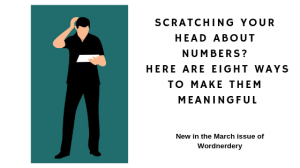 Love them or hate them, numbers are all around us. Whether numbers mean anything to your reader or not often comes down to how well they are explained.
Love them or hate them, numbers are all around us. Whether numbers mean anything to your reader or not often comes down to how well they are explained.
I recently ran across Making Data Meaningful (pdf), a guide designed to be “a practical tool to help managers, statisticians and media relations officers bring statistics to life.” Issued by (surprise!) the United Nations Economic Commission for Europe, it includes input from Statistics Canada, the U.S. Census Bureau and other stats-keeping bodies.
“The number alone is not the story,” the guide says. “A statistical story shows readers the significance, importance and relevance of the most current information. In other words, it answers the question: Why should my audience want to read about this?”
In the March issue of my newsletter, Wordnerdery, I share eight tips from the guide and other sources I found useful for explaining large and small numbers as well as statistics. They include this one:
“To make data meaningful, find the story it tells. Focus on how the findings affect people and what you want them to remember. Get to the point with a theme sentence that has no numbers, then explain.”
Read seven more tips in Wordnerdery.
Wordnerdery is a quick read about words, effective/expressive writing, newsletters and more. Are you a subscriber yet? If yes, thanks for reading! If not, you can sign up right now. In keeping with Canada’s anti-spam laws and just plain good manners, you can easily unsubscribe any time.
